Casio Key Portable Keyboard CTK-2400 Instruction Manual

Content
Introduction
The Casio Key Portable Keyboard CTK-2400 is an excellent entry-level instrument, perfect for beginners and hobbyists. It features 61 piano-style keys and offers a wide range of sounds with 400 built-in tones and 150 rhythms. The keyboard includes a sampling function with a built-in microphone, allowing users to create unique sounds. Additionally, the Step-Up Lesson system supports learning and skill development. The CTK-2400 is available for approximately $99.
Specifications
Model | CTK-2090/CTK-2400 |
Keyboard | 61 standard-size keys |
Maximum Polyphony | 48 notes (24 for certain tones) |
Tones | |
Built-in Tones | 400 |
Sampling Tones | 1 (Long Sampling) or 5 (Short Sampling) Sampling Time: 2 second (Long Sampling) or approximately 0.4 seconds each (Short Sampling) Effects: 5 types Sampling Demo Tune: 1 |
Reverb | 1 to 10, Off |
Metronome Beats per Measure Tempo Range |
0, 2 to 6 30 to 255 |
Song Bank Tunes |
110 |
Step Up Lesson | |
Lessons | 5 (Listen, Watch, Remember, Next, Auto) |
Lesson Part | L, R, LR |
Functions | Repeat, Voice Fingering Guide, Note Guide, Performance Evaluation |
Auto Accompaniment | |
Rhythm Patterns | 150 |
One Touch Presets | 150 |
Other Functions Transpose Tuning |
±1 octaves (–12 to +12 semitones) A4 = 415.5 to 465.9 Hz (Initial Default: 440.0 Hz) |
MIDI | 16 multi-timbre received, GM Level 1 standard |
Musical Information Function | Tone, Rhythm, Song Bank numbers and names, staff notation, fingering, pedal operation, tempo, measure and beat number, chord name, etc. |
Inputs/Outputs | |
USB port | TYPE B |
Sustain jack | Standard jack (sustain, sostenuto, soft, rhythm) |
Phones/Output jack | Stereo standard jack Output Impedance: 200Ù, Output Voltage: 4.5V (RMS) MAX |
Audio In jack | Stereo mini jack Input Impedance: 9kÙ, Input Sensitivity: 200mV |
Built-in microphone | |
Power Jack | 9.5V DC |
Power Supply | 2-way |
Batteries | 6 AA-size zinc-carbon batteries or alkaline batteries |
Battery Life | Approximately 3 hours continuous operation on alkaline batteries |
AC Adaptor | AD-E95100L |
Auto Power Off | Approximately 6 minutes (during battery operation) or 30 minutes (during AC adaptor operation) without any operation |
Speakers Output | 10cm × 2 2W + 2W |
Power Consumption | 9.5V = 7.7W |
Dimensions | 94.6 × 30.7 × 9.2 cm (37 1/4 × 12 1/16 × 3 5/8 inch) |
Weight | Approximately 3.4kg (7.5 lbs) (without batteries) |
Song List
SONG BANK
WORLD | |
001 | TWINKLE TWINKLE LITTLE STAR |
002 | LIGHTLY ROW |
003 | LONG LONG AGO |
004 | ON TOP OF OLD SMOKEY |
005 | SAKURA SAKURA |
006 | WHEN THE SAINTS GO MARCHING IN |
007 | AMAZING GRACE |
008 | AULD LANG SYNE |
009 | COME BIRDS |
010 | DID YOU EVER SEE A LASSIE? |
011 | MICHAEL ROW THE BOAT ASHORE |
012 | DANNY BOY |
013 | MY BONNIE |
014 | HOME SWEET HOME |
015 | AURA LEE |
016 | HOME ON THE RANGE |
017 | ALOHA OE |
018 | SANTA LUCIA |
019 | FURUSATO |
020 | GREENSLEEVES |
021 | JOSHUA FOUGHT THE BATTLE OF JERICHO |
022 | THE MUFFIN MAN |
023 | LONDON BRIDGE |
024 | UNDER THE SPREADING CHESTNUT TREE |
025 | SIPPIN’ CIDER THROUGH A STRAW |
026 | GRANDFATHER’S CLOCK |
027 | ANNIE LAURIE |
028 | BEAUTIFUL DREAMER |
029 | IF YOU’RE HAPPY AND YOU KNOW IT, CLAP YOUR HANDS |
030 | MY DARLING CLEMENTINE |
031 | LITTLE BROWN JUG |
032 | HOUSE OF THE RISING SUN |
033 | SHE WORE A YELLOW RIBBON |
034 | YANKEE DOODLE |
035 | MY OLD KENTUCKY HOME |
036 | SZLA DZIEWECZKA |
037 | TROIKA |
038 | WALTZING MATILDA |
039 | ON THE BRIDGE OF AVIGNON |
040 | I’VE BEEN WORKING ON THE RAILROAD |
041 | OH! SUSANNA |
042 | CAMPTOWN RACES |
043 | JEANNIE WITH THE LIGHT BROWN HAIR |
044 | TURKEY IN THE STRAW |
045 | JAMAICA FAREWELL |
EVENT | |
046 | SILENT NIGHT |
047 | WE WISH YOU A MERRY CHRISTMAS |
048 | JINGLE BELLS |
049 | JOY TO THE WORLD |
050 | O CHRISTMAS TREE |
PIANO/CLASSICS | |
051 | MARY HAD A LITTLE LAMB |
052 | LE CYGNE FROM “LE CARNAVAL DES ANIMAUX” |
053 | JE TE VEUX |
054 | SONATA op.13 “PATÉTIQUE” 2nd Mov. |
055 | HEIDENRÖSLEIN |
056 | AIR FROM “SUITE no.3” |
057 | SPRING FROM “THE FOUR SEASONS” |
058 | HABANERA FROM “CARMEN” |
059 | BRINDISI FROM “LA TRAVIATA” |
060 | HUNGARIAN DANCES no.5 |
061 | MINUET IN G MAJOR |
062 | MUSETTE IN D MAJOR |
063 | GAVOTTE (GOSSEC) |
064 | ARABESQUE (BURGMÜLLER) |
065 | CHOPSTICKS |
066 | DECK THE HALL |
067 | ODE TO JOY |
068 | AVE MARIA (GOUNOD) |
069 | SONATINA op.36 no.1 1st Mov. |
070 | PRELUDE op.28 no.7 (CHOPIN) |
071 | RÊVERIE |
072 | GYMNOPÉDIES no.1 |
073 | GOING HOME FROM “FROM THE NEW WORLD” |
074 | FÜR ELISE |
075 | TURKISH MARCH (MOZART) |
076 | SONATA op.27 no.2 “MOONLIGHT” 1st Mov. |
077 | ETUDE op.10 no.3 “CHANSON DE L’ADIEU” |
078 | THE ENTERTAINER |
079 | WEDDING MARCH FROM “MIDSUMMER NIGHT’S DREAM” |
080 | AMERICAN PATROL |
081 | FRÖHLICHER LANDMANN |
082 | LA CHEVALERESQUE |
083 | SONATA K.545 1st Mov. |
084 | LA PRIÈRE D’UNE VIERGE |
085 | VALSE op.64 no.1 “PETIT CHIEN” |
086 | LIEBESTRÄUME no.3 |
087 | JESUS BLEIBET MEINE FREUDE |
088 | CANON (PACHELBEL) |
089 | SERENADE FROM “EINE KLEINE NACHTMUSIK” |
090 | MARCH FROM “THE NUTCRACKER” |
EXERCISE | |
091-100 | EXERCISE I |
101-110 | EXERCISE II |
Fingering Guide
Fingered 1, Fingered 2 Chords
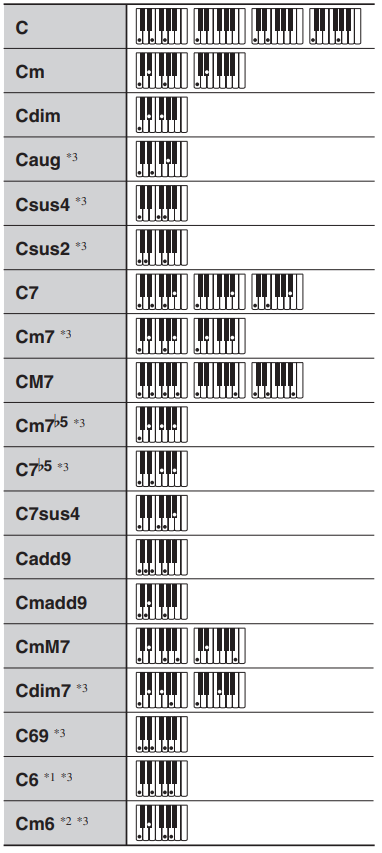
- With Fingered 2, interpreted as Am7.
- With Fingered 2, interpreted as Am7b5.
- Inverted form not supported in some cases.
Fingered 3, Full Range Chords

In addition to the chords that can be fingered with Fingered 1 and Fingered 2, the following chords also are recognized.
NOTE
- With Fingered 3, the lowest note fingered is interpreted as the base note. Inverted forms are not supported.
- With Full Range Chord, when the lowest note fingered is a certain distance from the neighboring note, the chord is interpreted as a fraction chord.
- Unlike Fingered 1, 2, and 3, Full Range Chord requires pressing of at least three keys to form a chord.
Chord Example List

Description
Usability was a primary consideration in the development of the Casio CTK-2400. The user interface of the keyboard is straightforward, with buttons that are easy to identify and a straightforward structure that makes it simple to move through the keyboard's many functionalities. The sound quality is remarkable, with tones that are both clear and rich, which contribute to an overall improvement in the playing experience.
Moreover, the mobility of the keyboard is an additional major advantage. Because of its weight of slightly more than seven pounds and its ability to be easily transported in a bag or backpack, it is an excellent choice for artists who are on the road or for students who need to bring their instrument to rehearsals or lessons.
Casio Key Portable Keyboard CTK-2400 General Guide
- In this manual, the term “Digital Keyboard” refers to the CTK-2090/CTK-2400.
- Illustrations in this User’s Guide show the CTK-2400.
- In this manual, buttons and other controllers are identified using the numbers shown below.
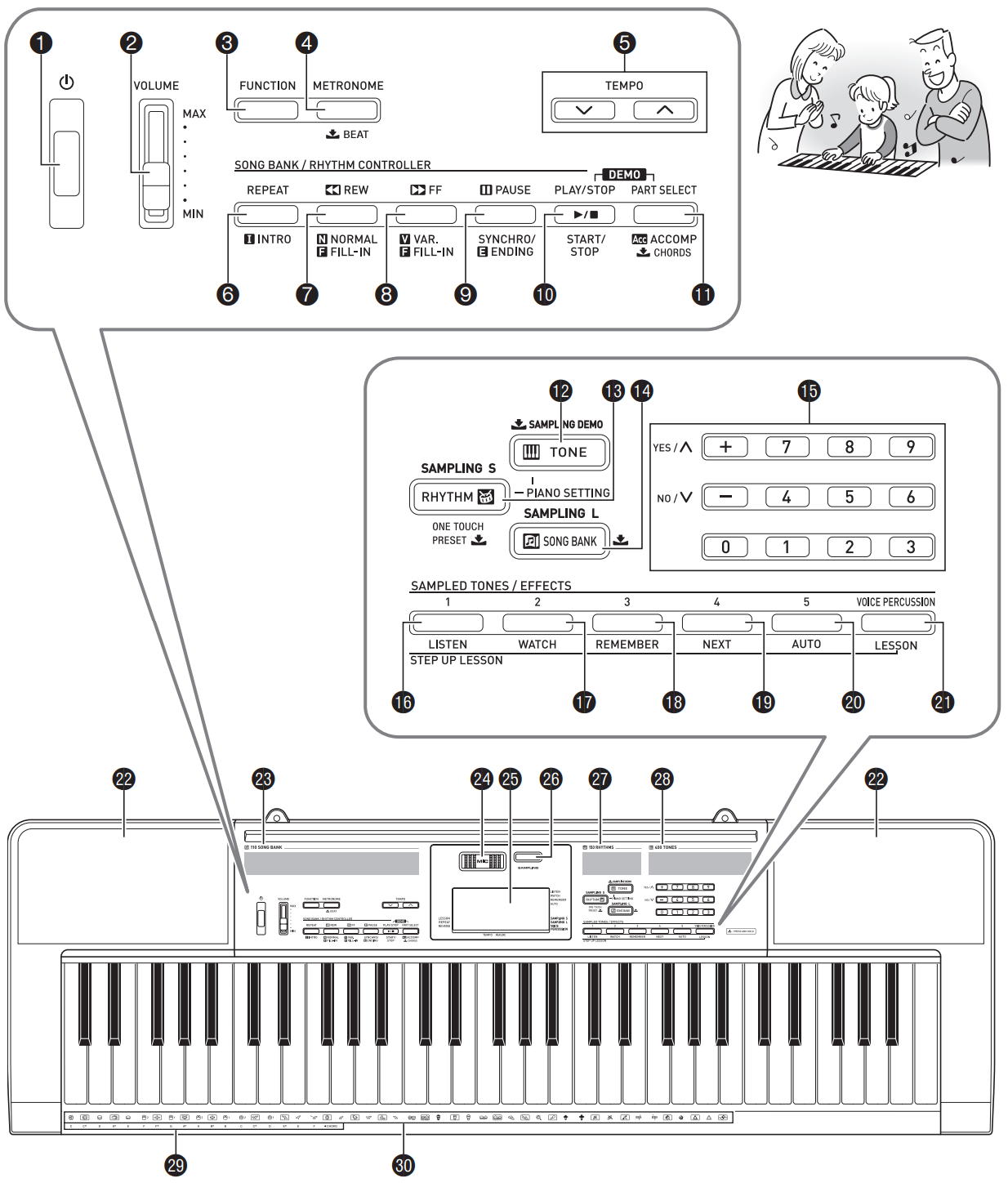
The following explains the meaning of the![]() symbol that appears on the product console and with the key names below. $: Indicates a function that is enabled by holding down the button for some time.
symbol that appears on the product console and with the key names below. $: Indicates a function that is enabled by holding down the button for some time.
 (POWER) button
(POWER) button - VOLUME slider
- FUNCTION button
- METRONOME,
 BEAT button
BEAT button - TEMPO buttons
- REPEAT, INTRO button
- REW, NORMAL/FILL-IN button
- FF, VAR./FILL-IN button
- PAUSE, SYNCHRO/ENDING button
- PLAY/STOP, START/STOP button
- PART SELECT, ACCOMP/
 CHORDS button
CHORDS button - TONE, SAMPLING DEMO button
- RHYTHM, ONE TOUCH PRESET
 button
button - boSONG BANK button
- Number buttons, [–]/[+] keys
- SAMPLED TONES/EFFECTS 1, LISTEN button
- SAMPLED TONES/EFFECTS 2, WATCH button
- SAMPLED TONES/EFFECTS 3, REMEMBER button
- SAMPLED TONES/EFFECTS 4, NEXT button
- SAMPLED TONES/EFFECTS 5, AUTO button
- VOICE PERCUSSION, LESSON button
- Song Bank list
- Built-in microphone
- Display
- SAMPLING button
- Rhythm list
- Tone list
- CHORD root names
- Percussion instrument list
USB port
Back
- SUSTAIN jack
- AUDIO IN jack
- DC 9.5V terminal
- PHONES/OUTPUT jack
Using the 10-key Pad
Use the number buttons and the [–] and [+] keys to change the settings of the parameters that appear in the upper left area of the display.
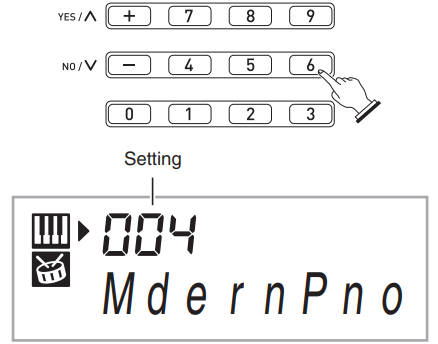
Number Buttons
Use the number buttons to enter numbers and values.
- Enter the same number of digits as the currently displayed value.
Example: To enter tone number 004, input 0 3 0 3 4. - Negative values cannot be input using the number buttons. Use [+] (increase) and [–] (decrease) instead.
[–] and [+] Keys
You can use the [+] (increase) and [–] (decrease) keys to change the displayed number or value.
- Holding down either key scrolls the displayed setting.
- Pressing both keys at the same time will revert to the initial default setting or the recommended setting.
Using the FUNCTION Button
Use the FUNCTION button (3) to access settings that let you select the reverb type, pedal effect, etc.
Press 3 (FUNCTION).
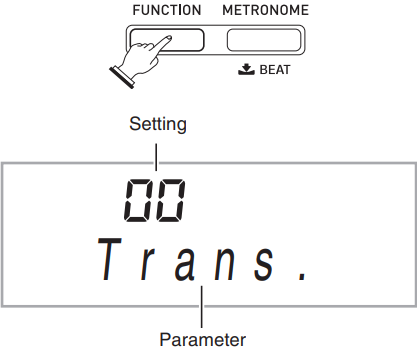
- Next press 3 (FUNCTION) until the parameter whose setting you want to change is displayed.
- Each press of 3 (FUNCTION) cycles through the available parameters.
To scroll backwards through parameters, hold down 3 (FUNCTION) as you press 4 (METRONOME).
Parameter Display See Page 1 Transpose Trans. EN-10 2 Accompaniment Volume AcompVol EN-31 3 Song Volume Song Vol EN-19 4 Tuning Tune EN-10 5 Reverb Reverb EN-9 6 Voice Fingering Guide Speak EN-24 7 Note Guide NoteGuid EN-25 8 Performance Evaluation Scoring EN-25 9 Phrase PhraseLn EN-25 10 Sampling Start SampAuto EN-15 11 Sampling Play Back SampPB EN-16 12 Auto Incrementing during Short Sampling AutoIncr EN-16 13 Keyboard Channel Keybd Ch EN-33 14 Navigate Channels Navi. Ch EN-33 15 Local Control Local EN-34 16 Accomp Out AcompOut EN-34 17 Pedal Effect Jack EN-9
- When the parameter you want is displayed, use bp (10-key) to change its setting.
The parameter setting will disappear from the upper left area of the screen if you do not perform any operation for some time.
Getting Ready to Play
Preparing the Music Stand
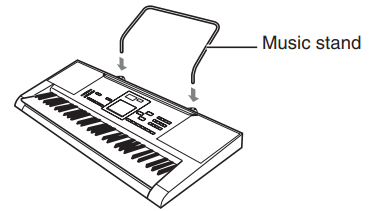
Power Supply
Either an AC adaptor or batteries can be used to power this Digital Keyboard. Normally, use of AC adaptor power is recommended.
- The AC adaptor does not come with this Digital Keyboard. Purchase it separately from your retailer. See page EN-1 for information about options.
Using the AC Adaptor
Make sure that you use only the AC adaptor specified for this Digital Keyboard. Use of a different type of AC adaptor can cause malfunction.

- Be sure to turn off Digital Keyboard power before connecting or disconnecting the AC adaptor.
- The AC adaptor will become warm to the touch after very long use. This is normal and does not indicate malfunction.
To prevent breaking of the wire, take care to avoid putting any type of load on the power cord.

- Never insert metal, pencils, or any other objects into the product’s 9.5V DC terminal. Doing so creates the risk of accident.
Using Batteries
IMPORTANT
- Be sure to turn off power before loading batteries.
- It is up to you to prepare six commercially available AA-size batteries. Do not use oxyride batteries or any other nickel based batteries
- Open the battery cover on the bottom of the Digital Keyboard.
- Load six AA-size batteries into the battery compartment.
Make sure the positive + and negative - ends of the batteries are facing as shown in the illustration. Insert the tabs of the battery cover into the holes on the side of the battery compartment, and close the cover.

Low Battery Indication
The indicator shown below starts to flash to let you know when battery power is low. Replace the batteries with new ones.

Controlling the Keyboard Sounds

Select from a variety of musical instrument sounds
Your Digital Keyboard lets you select tones for a wide variety of musical instrument sounds, including violin, flute, orchestra, and more. Even the same song sound takes on a different feel by changing the instrument type.
To select an instrument for playing
Press bm (TONE).
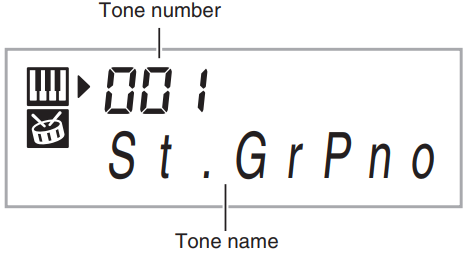
Use bp (10-key) to select the tone number you want.
The corresponding tone number and tone name will appear on the screen.- Use the number buttons to enter the tone number. Specify three digits for the tone number.
Example: To select 001, enter 0 3 0 3 1.
NOTE
- See the separate “Appendix” for a complete list of available tones.
- When one of the drum sets is selected (tone numbers 395 through 400), each keyboard key is assigned a different percussion sound.
Try playing something on the keyboard.
The tone of the instrument you selected will sound.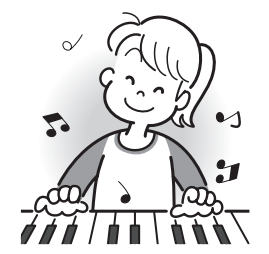
Playing with a Piano Tone (Piano Setup)
Press bm (TONE) and bn (RHYTHM) at the same time. This selects the grand piano tone.
Settings
- Tone Number: “001”
- Reverb: “06”
- Transpose: “00”
- Pedal Effect: SUS
- Rhythm Number: “131”
- Accompaniment: Rhythm part only
- Local Control: On
- Voice Percussion:Off
Using Reverb
Reverb adds reverberation to notes. You can change the duration of the reverb.
Press 3 (FUNCTION) a number of times until “Reverb” appears on the display.
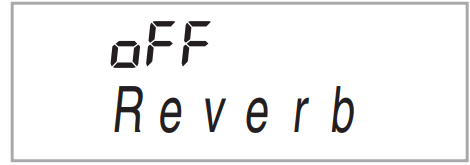
- Use bp (10-key) [–] and [+] keys to select the reverb setting you want.
| Off (oFF) | Turns off reverb. |
| 1 to 10 | The larger the number selected, the longer the reverb duration. |
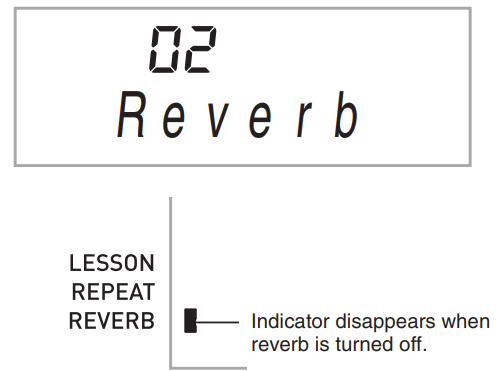
Using a Pedal
A pedal can be used to change notes in various ways while playing.
- A pedal unit does not come with the Digital Keyboard. Purchase one separately from your retailer. See page EN-1 for information about options.
Connecting a Pedal Unit
Connect an optional pedal unit.

Selecting the Pedal Effect
Press 3 (FUNCTION) a number of times until “Jack” appears on the display (page EN-4).

- Use bp (10-key) [–] and [+] keys to select the pedal effect you want.
The following shows the available pedal effects.
Sustain (SUS) Sustains notes played while the pedal is depressed. Organ and other similar tone notes are sustained even if the pedal is not pressed. Sostenuto (SoS) Sustains notes that are playing when the pedal is depressed before the keyboard keys are released. Soft (SFt) Slightly softens notes played while the pedal is depressed. Rhythm (rHy) Pressing the pedal starts and stops Auto Accompaniment or song playback.
Changing the Pitch (Transpose, Tuning)
Changing the Pitch in Semitone Steps (Transpose)
The transpose feature lets you change the pitch, in semitone steps. A simple operation lets you instantly change the pitch to match that of a singer.
The transpose setting range is –12 to +12 semitones.
Press 3 (FUNCTION).
_casio_key_portable_keyboard_ctk-2400.png)
- Use bp (10-key) [–] and [+] keys to select the transpose setting you want.
Fine Tuning (Tuning
Use the tuning feature when you need to adjust the pitch slightly to play along with another musical instrument. Also, some artists perform their music with slightly altered tuning. You can use the tuning feature to adjust tuning so it exactly matches a performance on a CD.
The tuning feature specifies the frequency of the A4 note. You can set a frequency within the range of 415.5 to 465.9 Hz. The initial default setting is 440.0 Hz.
Press 3 (FUNCTION) a number of times until “Tune” appears on the display (page EN-4).

- Use bp (10-key) [–] and [+] keys to adjust the tuning.
Performing this step causes the display to change from “Tune” to a value that indicates the current frequency setting as shown below. You can change the frequency in 0.1Hz steps.
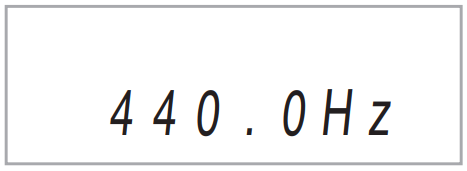
- Even if you do not perform a bp (10-key) operation to adjust the tuning, the current frequency setting will appear automatically after a few seconds.
Setup Guide
To set up the Casio,
- Start by unpacking the keyboard and ensuring all parts are included.
- Connect the AC adapter to the power input on the keyboard and plug it into a wall outlet. If using batteries, insert six AA batteries into the battery compartment.
- Turn on the keyboard by pressing the power button.
- Use the function buttons to select different tones, rhythms, and other features.
- For pairing with a device via USB, connect the USB cable to the keyboard and the other end to your computer or tablet. Download and install Casio's Chordana Play app to access additional functionalities.
Casio CTK-2400 Troubleshooting
Symptom | Action | |
Included Accessories | ||
I can’t find something that should be here. | Carefully check inside all of the packing materials. | |
Power Requirements | ||
Power will not turned on. |
| |
The Digital Keyboard outputs a loud sound and then suddenly powers down. | Replace the batteries with new ones or switch over to AC adaptor power (page EN-5). | |
The Digital Keyboard suddenly powers down after a few minutes. | This happens when Auto Power Off (page EN-6) is triggered. | |
Display | ||
The display keeps going out or are flashing. | Replace the batteries with new ones or switch over to AC adaptor power (page EN-5). | |
On-screen keyboard keys or notes remain on the display. | A Step Up Lesson is in progress and the Digital Keyboard is waiting for you to play the next note in the song. To stop this from happening, cancel the lesson (page EN-23). | |
Screen contents are visible only from straight ahead. | This is dues to production limitations. It does not indicate malfunction. | |
Sound | ||
Nothing happens when I press any keyboard key. |
settings (page EN-6). | |
Nothing happens or notes do not play normally when I play notes on the left side of the keyboard. | Press bl to disable chord input in the accompaniment keyboard area (page EN-28). | |
Nothing happens when I start an Auto Accompaniment. |
| |
Nothing happens when I start playback of a built-in song. |
| |
The metronome does not sound. |
| |
Notes keep sounding, without stopping. |
| |
Some notes are cut off while they are playing. | Notes are cut off whenever the number of notes being sounded exceeds the maximum polyphony value of 48 (24 for some tones). This does not indicate malfunction. | |
The volume or tone setting I made has changed. |
| |
In certain keyboard ranges, the volume and tone quality sound are slightly different from those in other keyboard ranges. | This is due to system limitations. It does not indicate malfunction. | |
With some tones, octaves do not change at the far ends of the keyboard. | This is due to system limitations. It does not indicate malfunction. | |
The pitch of the notes does not match other accompanying instruments or sounds strange when played long with other instruments. |
| |
The reverb of notes seems to change suddenly. |
| |
Sounds I sampled were deleted. | Be sure to press the power button to turn off power. Unplugging or disconnecting the AC adaptor without first pressing the power button to turn off power will cause sampled sounds to be deleted. | |
Even though I didn’t input anything with the built-in microphone, the message “Sampled!” appears on the display when I release the SAMPLING button. |
| |
Rhythms played in the VOICE PERCUSSION Mode sound strange and unnatural. | In order to assure proper balance for the rhythm, be sure to record all five short samples. Playing a rhythm in the VOICE PERCUSSION Mode while there is no short sample will cause a preset sample to sound. If there is even a single short sample recorded, rhythm instruments will sound only for the recorded short sample. | |
Operation | ||
When I perform a skip forward or skip back operation, the skip operation moves multiple song measures instead of only a single measure. | While song playback is stopped or a Step Up Lesson is in progress, skip forward and skip back operations are performed in phrase units (page EN-18). | |
Computer Connection | ||
I can’t exchange data between the Digital Keyboard and a computer. |
| |
Pros & Cons
Pros
- Lightweight and portable design
- Rich feature set with 150 rhythms and 400 tones
- Simple to use and with an intuitive interface
- Reasonably priced
- Touch sensitivity and an integrated educational system
- Compatibility with the Chordana Play app from Casio
Cons
- Restricted number of keys (61 full-size keys)
- MIDI output is absent (just USB)
- Absence of an integrated recording feature
- The built-in speakers seem weaker to certain users.
Customer Reviews
Consumers typically commend the Casio CTK-2400 for its excellent sound quality, affordability, and ease of use. Many novices enjoy the range of tones and rhythms offered as well as the integrated instruction structure. According to several customers, the keyboard is rather durable and can sustain years of frequent usage.
The restricted key count and absence of MIDI output are frequent grievances, which may make it unsuitable for more experienced pianists. All things considered, nevertheless, the CTK-2400 is well recognized for its adaptability and appropriateness for both beginning and intermediate players.
Faqs
Does the Casio come with a USB port?
Can I use the Casio Key Portable Keyboard with batteries?
Is there a built-in lesson system on the Casio?
How many tones and rhythms does the Casio Key Portable Keyboard offer?
Is the Casio compatible with any music learning apps?
Does the Casio have touch sensitivity?
Can I connect a microphone to the Casio?
What is the key count of the Casio?
Does the Portable Keyboard have built-in speakers?
Leave a Comment
